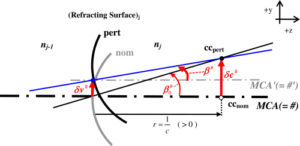Kevin P. Thompson, Tobias Schmid, Ozan Cakmakci, and Jannick P. Rolland
in JOSA A
It has been found that the field dependence of the aberrations of misaligned optical systems made of otherwise rotationally symmetric optical surfaces are often multinodal, including low-order astigmatism and distortion and higher-order coma, astigmatism, oblique spherical, elliptical coma (trifoil), and distortion. The exact location of the nodes in the image is a weighted sum of individual surface contributions. The location of the center of rotational symmetry for the field dependence for all aberrations contributed by a particular rotationally symmetric surface is along the line that connects the center of curvature of the surface with the center of the pupil. Previously, a paraxial ray-trace method was developed to locate the aberration field center for a series of rotationally symmetric surfaces with small tilt and decenter perturbations. The method is based on rotating the coordinate system into the local coordinate system of the surface and then advancing using the conventional paraxial ray-trace equations. This method, developed by Buchroeder [Ph.D. dissertation (University of Arizona, 1976)] , heavily constrains how tilts and decenters were implemented in the optical system model, which prevented integration of these equations into an optical design environment. In this paper, a method for locating the aberration field centers using real-ray-trace data that is entirely model independent and, significantly, that is not restricted to small tilts and decenters, is presented. With this new insight, it is now possible to extend any optical design and analysis environment to include multinodal aberration analysis.



